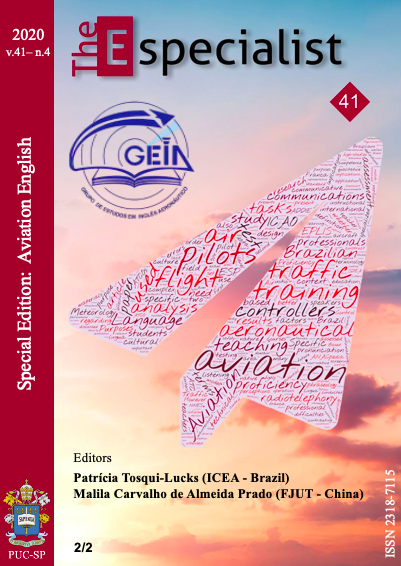Developing an aeronautical English training unit based on the ADDIE model in an EFL context
DOI:
https://doi.org/10.23925/2318-7115.2020v41i4a6Keywords:
ADDIE Model, Aeronautical English, English for Specific Purposes (ESP), Instructional DesignAbstract
The precision and effectiveness of the communication between air traffic controllers and pilots is quite literally a matter of life or death. Speakers of aeronautical English, the language of communication in the realm of aviation, are required by the ICAO to meet a minimum standard of language performance across the communication skills of listening and speaking, yet miscommunication and misunderstandings across channels persist, potentially resulting in catastrophic collisions and incidents. This English for Specific Purposes (ESP) paper reports on the creation of an aeronautical English training unit guided by principles of the ADDIE (analysis, design, development, implementation, and evaluation) model of instructional design developed to assist Korean army enlisted soldiers and noncommissioned officers who are serving as air traffic controllers in the improvement of integral aeronautical English skills. Designed materials were assessed with the assistance of four subject-matter experts (SMEs) as a pilot test, and results of the evaluation demonstrate the potential for application of the ADDIE model of instructional design for future ESP instructional units.
References
AGLUGUB, C. E. 2013. The relationship between learning style and job performance of U.S. Navy aviation maintenance technicians. Doctoral dissertation, Embry-Riddle Aeronautical University.
ALDERSON, C. 2009. Air Safety, Language Assessment Policy, and Policy Implementation: The Case of Aviation English. Annual Review of Applied Linguistics, 29: 168-187.
ALDERSON, J. C.; M. SCOTT. 1992. Insiders, outsiders and participatory evaluation. In ALDERSON, J. C.; A. BERETTA (Eds). Evaluating second language education. Cambridge, UK: Cambridge University Press, p. 25-58.
BACHMAN, L. F.; A. S. PALMER. 1996. Language testing in practice: Designing and developing useful language tests. Oxford: Oxford University Press.
BERLYNE, D. 1965. Structure and Direction in Thinking. New York: John Wiley and Sons, Inc.
BOSCHEN, A.C.; R.K.JONES. 2004. Aviation language problem: Improving pilot-controller communication. Paper presented at the Professional Communication Conference, IPCC 2004, 29 September–1 October, p. 291-299.
BROWN, J. D. 1995. The elements of language curriculum: a systematic approach to program development. Boston: Heinle and Heinle.
CIVIL AVIATION AUTHORITY (CAA), 2006. European Safety plan 2006/07–2010/11. Safety Regulation Group, No.1, 2006.
CUSHING, S. 1994. Fatal words: communication clashes and aircraft crashes. Chicago, IL: University of Chicago Press.
EUROCONTROL. 2006. The European action plan for the prevention of runway incursions. Available at: <http://www.eurocontrol.int/runwaysafety/gallery/content/ public/docs/EAPPRI%201_2.pdf>. Access: 31 Aug 2008.
EUROCONTROL. 2017. European Action Plan for the Prevention of Runway Incursions (EAPPRI), Version 3.0. [online]. Available at: <https://www.eurocontrol.int/sites/default/files/2019-06/european-action-plan-prevention-runway-incursions-v3.pdf>. Access: 22 Jun 2020.
ICAO. 2004. Manual on the Implementation of ICAO Language Proficiency Requirements (1st ed): International Civil Aviation Organization. International Civil Aviation Organization.
ICAO. 2009. Guidelines for Aviation English Training Programmes (Cir 323 AN/185). Montreal, Canada: Internaltional Civil Aviation Organization.
ICAO. 2016-a. Manual on Air Traffic Controller Competency-based Training and Assessment (Doc 10056 AN/519). Montreal, Canada: International Civil Aviation Organization.
ICAO. 2016-b. Procedures for air navigation services-air traffic management (Doc 4444).
Montreal, Canada: International Civil Aviation Organization.
KARIMI, P.; R.V. SANAVI. 2014. Analyzing English language learning needs among students in aviation training program. Procedia-Social and Behavioral Sciences, 98, 852-858.
KELLER, J. 1987. Strategies for stimulating the motivation to learn. Performance & Instruction, 26.8: 1-7.
KRUSE, K. 2011. Introduction to instructional design and the ADDIE model. Available at: <http://www.transformativedesigns.com/id_systems.html>. Access: 30 Jun 2020.
MEISHELLA, T. H. 2018. Designing English speaking material for cabin crew in Jogja Flight School. Doctoral dissertation, Sanata Dharma University.
MIDKIFF, A. H.; R.J. HANSMAN; T.G. REYNOLDS. 2004. Air carrier flight operations. Cambridge, MA: MIT International Center for Air Transportation.
MOERE, A.V.; M. SUZUKI; R. DOWNEY; J. CHENG. 2009. Implementing ICAO Language Proficiency Requirements in the Versant Aviation English Test. Australian Review of Applied Linguistics, 32.3: 27.1-27.17.
MOLENDA, M.; C.M. REIGELUTH; L.M. NELSON. 2003. Instructional design. In L. Nadel (Ed.). Encyclopedia of Cognitive Science, London, Nature Publishing Group, 2: 574-578.
MORRISON, G.R.; S.M. ROSS; J.E. KEMP. 2010. Designing Effective Instruction, 6th. ed. Hoboken, NJ: Wiley.
NETO, J. F. D. B. 2012. E-learning in Multi-cultural Environments: An Analysis of Online Cabin Crew Training. Dissertation, Embry-Riddle Aeronautical University. Available at: <https://commons.erau.edu/edt/28>. Access: 30 Aug 2020.
PARK, M. 2018. Innovative assessment of aviation English in a virtual world: Windows into cognitive and metacognitive strategies. ReCALL, 30:2: 196-213.
PARK, M. 2020. Investigating Target Tasks, Task Phases, and Indigenous Criteria for Military Aviation English Assessment. Language Assessment Quarterly, 17.3: 1-26.
PARRISH, P. 2009. Aesthetic principles for instructional design. Education Tech Research Dev, 57: 511-528.
PRINZO, O.V. 1996. An analysis of approach control/pilot voice communications. No. DOT/FAA/AM-96/26. Washington, DC: Federal Aviation Administration.
SEXTON AND COMPANY. 2012. Training Process. Denver, Colorado Training. Available at: <http://www.denvercoloradotraining.com/about-the-training-development-company/denver-colorado-training-process/>. Access: 30 Aug 2020.
SHIN, D.; H. KIM. 2005. English for aviation specific purposes: needs analysis for English proficiency requirements. Korean Journal of Applied Linguistics, 21.2: 193-217.
SILVA, A.L.B.C.; P. TOSQUI-LUCKS. 2020. Around the world in aeronautical and aviation English courses. Revista CBTecLE, 2:1. Available at: <https://revista.cbtecle.com.br/index.php/CBTecLE/article/view/274>. Access: 30 Aug 2020.
TIAN, X., S. SUPPASETSEREE. 2013. Development of an instructional model for online task-based interactive listening for EFL learners. English Language Teaching, 6.3: 30-41.
TIEWTRAKUL, T.; S.R. FLETCHER. 2010. The challenge of regional accents for aviation English language proficiency standards: A study of difficulties in understanding in air traffic control–pilot communications. Ergonomics, 53.2: 229-239.
WEVER, R.; G.V. ES; M. VERBEEK. 2006. Air-ground communication safety study: causes and recommendations. Brussels: EUROCONTROL.
Downloads
Published
How to Cite
Issue
Section
License
The authors grant the journal all copyrights relating to the published works. The concepts issued in signed articles are the absolute and exclusive responsibility of their authors.


 Esta obra está licenciada com uma Licença
Esta obra está licenciada com uma Licença 